
The Phasmatodea are an order of insects whose members are variously known as stick insects, stick-bugs, walking sticks, stick animals, or bug sticks. They are generally referred to as phasmatodeans, phasmids, or ghost insects. Phasmids in the family Phylliidae are called leaf insects, leaf-bugs, walking leaves, or bug leaves. The group's name is derived from the Ancient Greek φάσμα phasma, meaning an apparition or phantom, referring to their resemblance to vegetation while in fact being animals. Their natural camouflage makes them difficult for predators to detect; still, many species have one of several secondary lines of defense in the form of startle displays, spines or toxic secretions. Stick insects from the genera Phryganistria, Ctenomorpha, and Phobaeticus include the world's longest insects.

The family Phylliidae contains the extant true leaf insects or walking leaves, which include some of the most remarkably camouflaged leaf mimics (mimesis) in the entire animal kingdom. They occur from South Asia through Southeast Asia to Australia. Earlier sources treat Phylliidae as a much larger taxon, containing genera in what are presently considered to be several different families.
Phobaeticus kirbyi is a very long stick insect native to Borneo. The holotype deposited at the Natural History Museum in London measures 328 mm (12.9 in) excluding legs and 546 mm (21.5 in) including legs. This makes it the second-longest known insect in terms of body length, behind Phobaeticus chani with 357 mm (14.1 in). Both P. chani and Phobaeticus serratipes exceed it in total length with legs extended. However, recent specimens of P. kirbyi have only reached 283 mm (11.1 in) in body length.
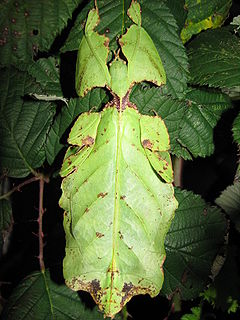
Pulchriphyllium giganteum, commonly known as the Giant Malaysian Leaf insect, is a species of leaf insects described from Malaysia by Hausleithner in 1984 and placed in the genus Pulchriphyllium since 2021. Pulchriphyllium giganteum is the largest species belonging to the genus Pulchriphyllium reaching 105 mm in size. They are found most abundantly in the west Malaysian tropics. The females typically have large elytra that lie edge to edge on the abdomen and tend to lack hind wings making them usually flightless. Males have small elytra and sometimes transparent non-leaflike functional hind wings. Pulchriphyllium giganteum found in the wild tend to be mostly females and the first male of this species was not found until 1994. In captivity, the species has primarily been observed to reproduce through parthenogenesis meaning the females are asexual. The primary reproductive pattern in the wild is unknown. Eggs tend to be brown or black and glossy and resemble the look of seeds. They hatch around 6 months after breeding. Newly hatched young nymphs tend to be wingless and brown or reddish in color. They develop their green color after feeding on leaves. Both the adult and larval stages are phytophagous meaning they feed on plants. The main plant food sources for this species are oak and bramble tree leaves.

Pulchriphyllium bioculatum, or Gray's leaf insect, is a leaf insect of the family Phylliidae native to tropical Asia as well as Madagascar, Mauritius and the Seychelles. It was first described by George Robert Gray in 1832, which was his first phasmid he discovered. Leaf insects have extremely flattened, irregularly shaped bodies, wings, and legs. They are usually about 5–10 cm long. They are called leaf insects because their large, leathery forewings have veins that look similar to the veins on the particular type of leaves they inhabit. Its scientific name bioculatum means "two-eyed" and refers to the two dots located on the abdomen just in this species.
Cryptophyllium athanysus, is a species of phasmid or stick insect of the genus Cryptophyllium. It is found in Sri Lanka.

Phyllium hausleithneri, ore Hausleithner's stick insect, is a species of phasmid or leaf insect of the genus Phyllium. It is found in peninsular Malaysia, and Sri Lanka.
Nanophyllium brevipenne, is a species of phasmid or leaf insect of the genus Nanophyllium. It is found in New Guinea, and Sri Lanka.
Pseudomicrophyllium geryon is a species of phasmid or leaf insect. It is found in the Philippines, Java (Indonesia), and Sri Lanka.

Phyllium jacobsoni is a species of leaf insect belonging to the family Phylliidae. Its recorded distribution is Java and no subspecies are listed in the Catalogue of Life.
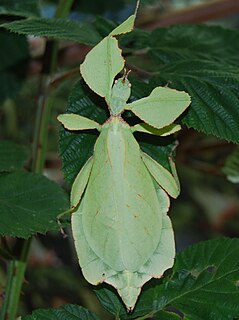
Cryptophyllium westwoodii is a species of leaf insect in the family Phylliidae. It is distributed from the Andaman islands, Myanmar, Indo-China, southern China, Sumatra and the Riouw Archipelago.

Orestes draegeri is a species of stick insects in the subfamily Dataminae.

Phyllium bilobatum is a species of leaf insect in the family Phylliidae. It is found in the Philippines and Malaysia. This species was first described in 1843 by the English zoologist George Robert Gray, who gave it the name Phyllium bilobatum. It has been assigned to the subgenus Phyllium, which is to be distinguished from the second subgenus Pulchriphyllium, within the genus Phyllium. The holotype is a female from the Philippines, which is kept in the Natural History Museum, London where Gray worked cataloguing insects.
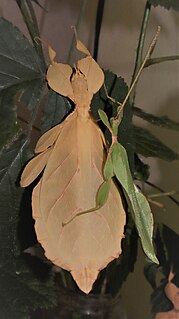
Phyllium letiranti is a species of phasmid or walking leaf of the genus Phyllium. It is currently only found in Peleng, Indonesia.
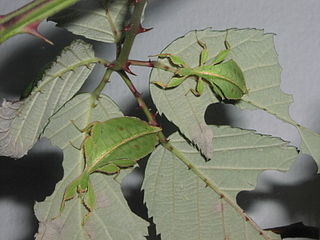
Cryptophyllium is a new (2021) genus of leaf insects in the tribe Phylliini. The current distribution is probably incomplete, but includes southern China, Sri Lanka, Indo-China, Malesia and western Pacific islands.
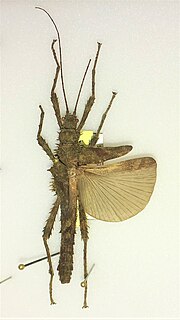
Miroceramia is a monotypic genus of stick insects, containing Miroceramia westwoodii as the only described species. It is the only fully winged one of the subfamily Obriminae.

Phyllium mabantai is a species of leaf insect in the family Phylliidae. It is endemic to the Philippines.

Phyllium philippinicum is a species of leaf insect in the family Phylliidae. It is endemic to the Philippines.
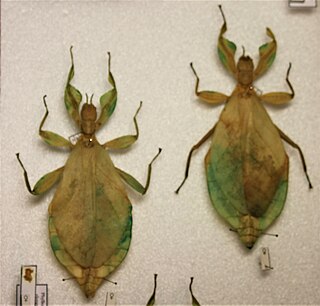
Phyllium elegans is a species of insect in the family Phylliidae. It is endemic to New Guinea.















